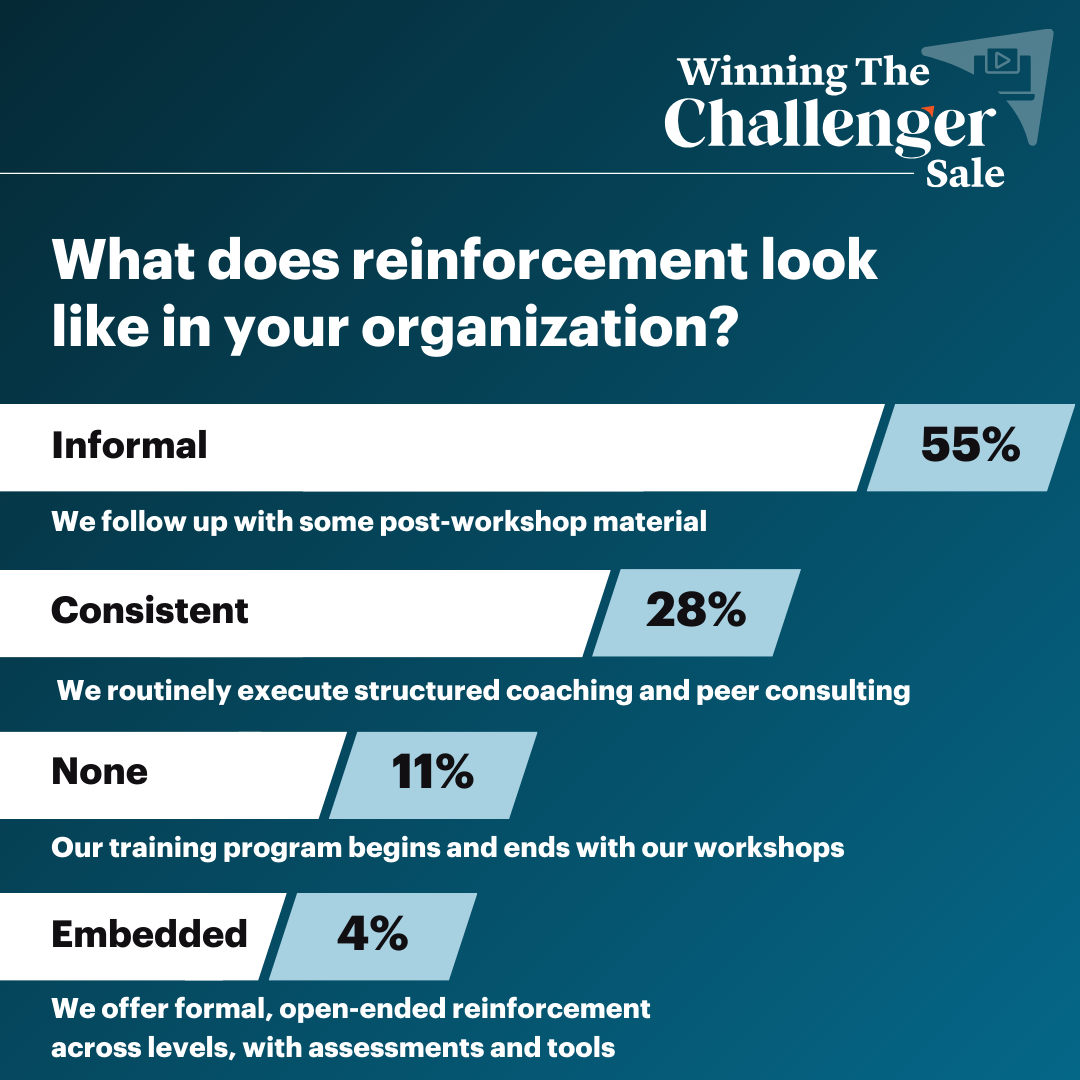Any sales leader deserving of that title knows that they need a sales methodology.
Sometimes, they build the SKO around it. Maybe they roll it out mid-year. Either way, they follow a typical path: they outline what they need in terms of process and common language, book the workshop and thrill to the excitement they see reflected in their GTM teams and sales reps.
All that time and effort from the sales leadership and the enablement team builds enthusiasm and interest, and yet… when we asked sales leaders about how reinforcement fits into their training programs, over two-thirds said they don’t follow up with formal programs.

What these leaders don’t realize is that without reinforcement and coaching, even the most enthusiastic sellers struggle to adopt a methodology and engage in true behavioral change that impacts their ability to win and grow.
It’s an area where many companies falter and one where the stakes are high: According to Ebbinghaus’s “Forgetting Curve” theory, organizations that don’t provide reinforcement risk sellers losing around 87% of that new knowledge within just 30 days.
The good news is that we’ve seen coaching and reinforcement programs add incredible value to Challenger training investments. As our client Connection demonstrated during the webinar session “Scaling a Culture of Coaching and Reinforcement,” you can embed reinforcement into training right in your corporate DNA — and this starts before you even roll out a new sales methodology.
Launching with buy-in from leadership
As Dennis Riseman, VP of sales at Connection, shared on our recent webinar, embedding a methodology into your sales culture requires visible leadership buy-in from the get-go.
“We wanted to make sure that we didn’t treat this as a training event,” Dennis said. “We really didn’t want was for our sellers to come to this event, get trained, walk out saying ‘This is great!’ and then go back to doing what they’ve always done.”
Instead, they kicked off training with a simple, powerful story from a member of the executive team.
“He talked about how one of our top sales reps had a conversation with one of his most dedicated customers,” Dennis explained. “They’ve been working with us for 20 years. And the customer said, ‘Hey, one of your competitors called me up and offered me a really strong insight about our business. It was something I wasn’t even thinking about. So I gave him the business because he earned it.’”
That loss pushed the executive to seek out Challenger because he needed an Insight-led methodology. Sharing that experience helped Connection’s sellers understand what was at stake.
Plan a cross-functional rollout
Start planning your rollout by considering which sales functions need training the most. While it’s tempting to focus on high performers (who are easier to work with) or low performers (who might want or need the most assistance), many organizations find the biggest impact from coaching core performers.
Challenger calls this concept moving the middle because core performers make up the largest proportion of most sales teams and represent the most potential impact for your training investment. Positive results from this group can create more organic internal interest in training.
As Dennis shared, “One of our strong sales reps sat in an early session and realized: ‘Hey, I’m what’s known as a Relationship Builder!’ He had this realization that he really struggled with Constructive Tension. So he committed to it. His manager committed to coaching him, and he did a lot of work with his peers to improve in this area.”
Eventually, that seller moved up to the highest level of sellers at Connection — and shared that his training and, crucially, follow-up with his manager helped him feel confident bringing Insight to his clients.
A true cross-functional rollout also needs to include frontline and mid-level managers, as well as technology and marketing specialists. With training under their belts, this team can offer support to sellers as they get used to a new methodology and ensure that it’s embedded throughout the organization and customer interactions.
Leverage peer consulting groups
After drumming up enthusiasm and launching a sales training program, sellers need a comfortable place to practice their new skills. At the request of team members, Connection added peer consulting groups to its Challenger selling curriculum.
These small, cross-functional groups came from across the company and included generalists and specialists who could review what they were learning and solve problems together. This format removed an element of pressure that may have kept sellers from raising questions with superiors or sales leaders during their training sessions.
“We saw our win rates go up, we saw more engagement from our people when it came to Challenger, and even outside of Challenger…that collaboration went up another level altogether,” Dennis said.
Hear more about Connection’s approach to peer consulting in this short clip from our webinar.
Maximize your training investment with reinforcement
Organizations looking to maximize their investments in a new training methodology can’t afford to overlook the importance of reinforcement. By pausing to gain (and broadcast) executive buy-in, creating a cross-functional rollout plan, and embedding reinforcement in your LMS, organizations can ensure that their investment in a methodology isn’t just a one-off initiative but the beginning of a true cultural change.
This is just the beginning! To see the complete six-step plan Connection used to gain 13:1 ROI on their Challenger training investment, watch the on-demand replay of our Winning The Challenger Sale webinar, “Scaling a Culture of Coaching and Reinforcement.”
Challenger, Inc.
Challenger is the global leader in training, technology, and consulting to win today’s complex sale. Our sales transformation and training programs are supported by ongoing research and backed by our best-selling books, The Challenger Sale, The Challenger Customer, and The Effortless Experience.
More from our blog
3 Challenger Skills That Boost Sales Rep Productivity and Motivate Buyers
Sales leaders everywhere are looking for ways to improve sales rep productivity. But productivity isn’t just about efficiency—it’s about…
Sending Commercial Teaching Messages That Inspire Action—Not Anxiety
How to Build Tension in Your Commercial Teaching Message In B2B sales, the most powerful messages aren’t horror stories, they’re dramas with a clear…
The Next Era of Challenger Selling: Skills That Will Shape the Future of Sales
In 2020, selling changed overnight. Buyers went quiet, priorities flipped, and digital interactions replaced boardroom handshakes. Everyone talked…
What are you waiting for?
Transform your sales team.
The best companies grow, and grow fast, by challenging customers, not by serving them.




